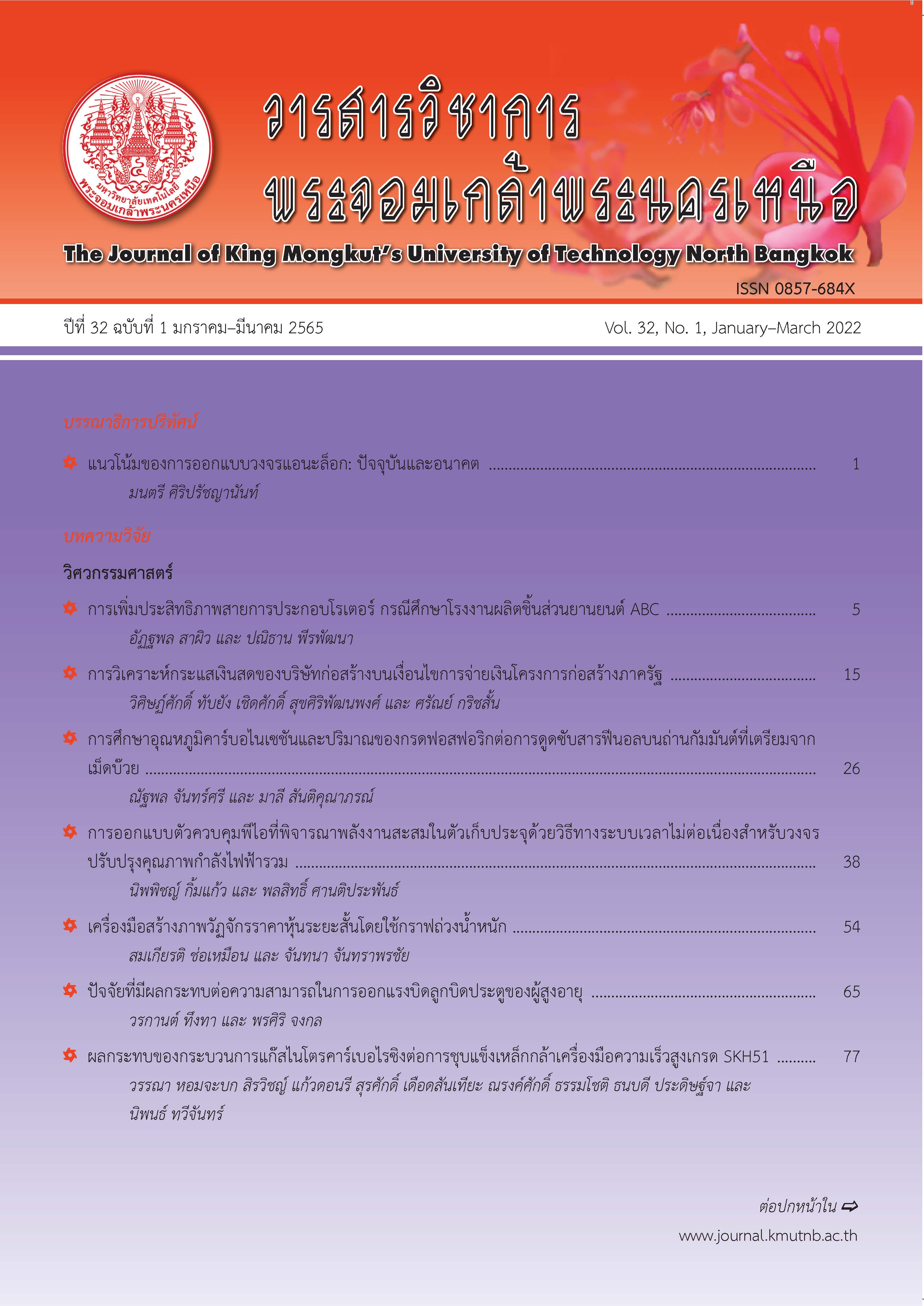คลื่นสมองของการพูดโกหกของมนุษย์ โดยใช้วิธีการวัดเพื่อบันทึกกิจกรรมไฟฟ้าในสมองบริเวณรอบๆ หนังศีรษะ (EEG) ด้วยเครื่องมือน้ำหนักเบา
Main Article Content
บทคัดย่อ
การทำงานของสมองในการทำกิจกรรมต่างๆ นั้น ก่อให้เกิดกระบวนการรับส่งสารเคมีผ่านนิวรอนซึ่งจะก่อให้เกิดคลื่นไฟฟ้าขนาดเล็ก โดยในปัจจุบันได้มีการสร้างอุปกรณ์สำหรับทำการบันทึกข้อมูลคลื่นไฟฟ้าที่เกิดจากสารเคมีในสมองได้หลากหลาย วิธีการที่ง่ายที่สุดคือการใช้วิธีการวัดเพื่อบันทึกกิจกรรมไฟฟ้าในสมองบริเวณรอบๆ หนังศีรษะ (EEG) โดยมีการนำเครื่องมือวัดที่ติดตั้งแผ่นรับสัญญาณอิเล็กโทรดไว้บริเวณจุดสำคัญบนหนังศีรษะ ในงานวิจัยนี้ใช้อุปกรณ์ชื่อ NeuroSky MindWave บันทึกกิจกรรมไฟฟ้าในสมองบริเวณรอบๆ หนังศีรษะ (EEG) โดยทำการทดลองตอบคำถามจากการมองเห็นแบบถูกต้องและแบบไม่ถูกต้องจากผู้เข้าร่วมการทดลองจำนวน 5 คน โดยนำภาพสัตว์จำนวน 8 ชนิดมาใช้ ในรอบแรกให้ตอบชนิดของสัตว์ให้ถูกต้อง และในรอบที่ 2 ให้ตอบคำถามไม่ถูกต้อง โดยมีการกำหนดระยะเวลาในการเก็บข้อมูล 80 วินาทีในแต่ละรอบ โดยแบ่งให้มีการทำสมาธิ ในวินาทีที่ 1 ถึง 20 และวินาทีที่ 61 ถึง 80 และนำข้อมูลในวินาทีที่ 21 ถึง 60 มาวิเคราะห์ข้อมูล โดยให้ดูภาพละ 8 วินาที หลังจากที่ได้มีการวิเคราะห์ผลของสัญญาณโดยใช้การทดสอบสมมุติฐาน (Hypothesis Testing) โดยใช้ค่า t-test และค่า P แล้วปรากฏว่า สัญญาณคลื่นสมองอัลฟา ทีต้า และแกมมามีการเปลี่ยนแปลงในลักษณะสูงขึ้นกว่าเดิม และเป็นที่ยอมรับทางสถิติ
Article Details
บทความที่ลงตีพิมพ์เป็นข้อคิดเห็นของผู้เขียนเท่านั้น
ผู้เขียนจะต้องเป็นผู้รับผิดชอบต่อผลทางกฎหมายใดๆ ที่อาจเกิดขึ้นจากบทความนั้น
เอกสารอ้างอิง
[2] G. Schalk and J. Mellinger, A Practical Guide to Brain–Computer Interfacing with BCI2000. London: Springer., 2010, pp. 9–10.
[3] NeuroSky. (2009, December). Brain Wave Signal (EEG) of NeuroSky, Inc [online]. Available : http://sleepshepherd.com/wp-content/uploads/2016/02 /neurosky-vs-medical-eeg.pdf
[4] J. Naraballobh, D. Thanapatay, and J. Chinrungrueng, “Effect of auditory stimulus in EEG signal using a brain-computer interface,” presented at the 12th International Conference on Electrical Engineering/Electronics, Computer, Telecommunications and Information Technology (ECTI-CON), Hua Hin, Thailand, 2015 (in Thai).
[5] P. Sittiprapaporn, T. Khampratheang, S. Taseetong, and Djohan, “Lightweight electroencephalohraphic study of spatial ability in adult obesity,” presented at the 15th International Conference on Electrical Engineering /Electronics, Computer, Telecommunications and Information Technology (ECTI-NCON 2018), Chiang Rai, Thailand, 2018 (in Thai).
[6] A. B. Genete, C. R. E. Mancilla, L. R. Mauleon, I. X. S. Roperos, and J. D. O. Tateligan, “ThinkGearTM pattern recognition algorithm for body movements using relativity,” presented at International Conference On Circuits, Systems, Communications, Computers And Applications, Kuala Lumpur, 2015.
[7] P. Khemapathumak, S. Lookhanumanchao, and P. Sittiprapaporn, “EEG power spectra during stroop color word task training in obese patients,” presented at the 14th International Conference on Electrical Engineering/Electronics, Information Technology (ECTI-CON), Phuket, Thailand, 2017 (in Thai).
[8] E. A. Larsen, “Classification of EEG signals in a brain-computer interface system,” M.S. thesis, Department of Computer and Information Science, Norwegian University of Science and Technology, Trondheim, 2011.
[9] NeuroSky. (2009, December). NeuroSky Developer Document [Online]. Available: http://developer. neurosky.com/docs/doku.php?id=neurosky_101
[10] The MathWorks Inc. (2017, March). MATLAB, [Online]. Available : https://www.mathworks.com/help/pdfdoc /matlab/getstart.pdf
[11] NeuroSky. (2016, July 6). Stream SDK for PC Development Guide [Online]. Available: http:// developer.neurosky.com/docs/doku.php?id=developer_tools_2.5_development_guide
[12] NeuroSky. (2017, January). ThinkGear Serial Stream Guide [Online]. Available: http://developer.neurosky.com/docs/doku.php?id=developer_tools_2.5_development_guide

